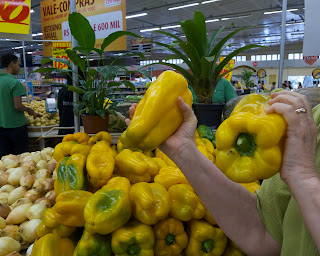Edible plants grow better in Brazil. There is such a wide range of good edible fruits and vegetables that it is a joy to visit the outdoor markets. It is a joy because you know that soon you will be enjoying some remarkable treats. Things like Mousse de Maracajá which is so addictive I think it can’t be part of a diet. (To make it, you use one can of condensed milk.) The Maracajá fruit itself we’ve never seen in the US. Of course the familiar fruits and vegetables are here, but the pineapple is sweeter, the peaches are huge, the tomatoes are usually ripe but still look green, a cabbage barely fits in a plastic sack, and the tangerines are called Mexericas and are bigger than navel oranges! What about peppers here! There are too many kinds of bananas to mention, all with good flavor. I will mention though that the potatoes here cannot compare to those great Idaho Spuds.
 |
| A Small Saturday Street Market |
 |
| Bananas - Bananas - Bananas |
 |
| Also in Red and Green! |
PHOTOGRAPHY - The cameras we selected to use here were predicated on the fact that there is almost always something to record and remember. While the small Panasonic Lumix DMC-LX5 has a protruding lens, even when closed, it disappears well in my ScotteVest camera pocket. We are not tourists here. Carrying a regular DSLR camera around just doesn’t work. Having the smaller cameras with us much of the time makes it possible to take photos when they appear and most of the time no one even notices.
I must say that having three very important books loaded on my Kindle reading app has made a great difference in the use of this camera as well as any other digital camera such as my Nikon D40. The most important book is one I recommend for all camera owners. Understanding Exposure, 3rd Edition by Bryan Peterson. Having the book available on my MacBook Pro laptop allows quick reference with great color images whenever a skill needs tweaking. The book will put you in the practice initially of using the “M” mode on your digital camera, one which most point and shoot photographers would never voluntarily use. After a few weeks of carrying the camera and using this mode, I began to really understand what makes a great “creatively exposed” photo. Aperture and Shutter Speed are the two easiest parts of the exposure lessons but then along comes ISO which became my friend after a few weeks of having to think about all three parts of this Photographic Triangle.
Today’s smaller cameras often have one setting that most people use at all times. It is the “iA” setting which means “intelligent Auto” and is the setting with which the photographer does not need to think. The camera makes all the decisions for you. Because the “i” in the symbol is a lower case i, perhaps it should be thought of as “not so intelligent.” If you learn to know and use the many other settings in these cameras, your ability to take much better, creatively exposed photos will increase and your satisfaction with your camera will rise exponentially.
The other two important books I will reference later in another Blog post. Both of them are more specific to the camera, the Panasonic Lumix DMC-LX5, and the photo management system with the Apple Aperture 3.
Jim's being kind in not telling anybody I'm a "Point & Clicker". I even take pictures thru the car wiindshield if necessary to not miss a shot I know I'll probably never get again. Jim's the photographic artist and I'm so glad that he is but I'm happy and my camera makes me look like a better photographer than I really am.
ReplyDelete